
Atlas F1 Technical Writer
The Japanese Grand Prix offered the teams some unusual challenges, with extreme weather condition changes and a modified weekend schedule. While no real changes were seen on the cars at Suzuka, the circuit was a test for the technical staff, and Atlas F1's Craig Scarborough reviews how each team coped with throughout the weekend
This year's event was a little earlier than normal and the dramatic weather system that has hit many parts of the world recently, also paid a visit to the land of the rising sun.
Typhoon Ma-on was on a direct course towards Suzuka in the days leading up to the race, and as a result Friday's practice sessions were held in torrential rain and dark skies. Moreover, in preparation for the expected arrival of the typhoon on Saturday, the circuit shut its doors and qualifying was rescheduled for Sunday morning. This unusual weekend order also taxed the teams and drivers, as no extended dry running was completed prior to the race.
Suzuka is a specialist track, with long corners, hairpins, and a long straight. The layout of the corners is quite unusual, with double apexes requiring unconventional lines. As a result, some drivers with a lot of experience of the track tend to go well there, contradicting the belief that the circuit rewards only good cars. The long corners also provide problems for the tyres in the dry, and with only wet practice, most teams arrived at the race with tyre choice based largely on guesswork - some teams adopting split strategies to compensate for any errors.
As the circuit is tricky on car set-up, teams also had to select their set-up based on prior experience and guesswork, and in the race many drivers found the car far from ideal, using pitstops to alter tyre pressure or front wing settings.
Another element that differs from a wet set up is the ride height. In the wet, low ride height invites aquaplaning as the plank meets the wet ground. Teams lowered the cars in advance of the largely dry qualifying, and throughout the race yellow puffs of smoke were kicked up as the cars grounded excessively from being squashed down by the downforce. This possibly led to Mark Webber's retirement.
Wet weather and Suzuka's curvy layout also eased the pressure on engines. Although the track rates high on average engine speed, the drivers' need to balance the throttle through long corners means that open throttle and very high revs are not called for.
From a technical innovation perspective, Japan was a quiet race; no team brought any major developments as only little testing was completed between races. This was compounded by the fact that the wet sessions would serve no purpose in proving new parts and the risk of running untested part in the fewer remaining sessions was too high.
Weekend Running Order
With the extreme weather shaping the weekend's running order, the sessions were rescheduled to complete qualifying on Saturday. Friday's two sessions were run as usual, albeit hampered by the wet weather. Saturday's morning sessions were cancelled, and the two qualifying sessions were postponed to Sunday. Eventually, the cars were idle from Friday evening until pre qualifying at 09:00 on Sunday, rapidly followed by second qualifying.
Leaving the teams without the Saturday practice sessions, the teams' ability to test their (dry) qualifying and race set up was vastly limited. Subsequently, the FIA's race director did allow a special dispensation to change tyres and front wing settings before the race, as some teams had qualified on wet tyres.
Vortices
Visible vapour trails spiralling off the rear wing are often seen as a sign of efficiency, but in fact the opposite is true - they are a sign that drag is being generated by the wing.
Vortices are an atmospheric phenomenon caused by the high pressure air above the wing, meeting the low pressure below and to the side of the wing. The high pressure air rushes into the low pressure region and the tumbling effect begins. Each side of the wing produces a vortex, each rotating in a different direction. Although not visible even in damp conditions, these trails continue tens of metres behind the car, initially rising steeply and then flattening off.
This has impact on drag and the efficiency of the rear wing and diffuser. Teams strive to lessen the power of the vortex and also to make the vortices further apart. To do this, they try to equalise the pressure at the wing tip, either by increasing pressure outside the wing or reducing the pressure just inside the endplate.
A few years ago, these vortices would have been rising steeply and trailing directly behind the wing. Nowadays, the aerodynamic development sees the trails heading off almost horizontally to the wing and barely rising.
Although little conclusive comparison can be made from the different cars at the circuit, the trails created at the end of the main straight do see some comparisons, and McLaren were sporting the most visible trails, while the complex wings of many other teams barely produced a trail at all. In particular, the Renaults produced a very low vortex, created from under the curved-in rear flap.
Team by Team
Ferrari
No specific problems on Friday left the team enjoying the better performance of the Bridgestone wet tyres. After his dismal twelfth place in China, Michael Schumacher was the eighth to last out of the pits in the first qualifying and put in a time only to be beaten by Jarno Trulli, while Ruben Barrichello's win was penalised with a poorer slot.
Into the second session, Barrichello's early run was eclipsed by Schumacher's much later run on the drying track.
Starting the race from pole, Michael Schumacher was not challenged into turn 1 and was able to settle into an easy pace, stopping one lap after teammate Barrichello's stop on Lap 12, both drivers completing a three stop race.
Barrichello meanwhile had to fight through the field, finding the tyres improving as the track warmed up and rubberred in, until a coming together with David Coulthard wrecked his front suspension and forced him into retirement.
Williams
Sensibly running only for system checks and wet weather set up, the team were low on the time sheets Friday.
In the first qualifying session, Ralf Schumacher set the third fastest time and was able to go one better in the second qualifying session. His teammate Juan Pablo Montoya was the first driver to try dry-weather tyres in the second session and made a commendable effort, although with the track drying up from one run to another, his times were easily topped by those coming out after him.
In the race, Ralf started well and maintained his position, edging a gap out over the BARs in the early laps, but stopping as early as lap 11 for the first of his three stop strategy. Montoya meanwhile was in the midfield pack and soon stuck in a race for position with three other cars. A failed manoeuvre in the chicane on Olivier Panis cost him two subsequent places, as both Barrichello and Fisichella were able to pass him onto the straight.
Both the Williams drivers were able to run to the finish without other dramas for second and seventh.
McLaren
This time around the narrow nose and curved three element wing saw action on the MP4-19B; no other developments were announced or noticed.
Limiting their running in the wet conditions, both McLaren drivers showed good pace even on their Michelins and despite David Coulthard starting late after a precautionary clutch change.
First qualifying saw both drivers in the mid-field, and in the race both drivers were on a two stop strategy. Coulthard enjoyed a competitive race at one of his favoured circuits, but this ended on Lap 39, when his crashed with Rubens Barrichello, also wrecking his suspension.
Kimi Raikkonen had a slow first pitstop, with the fuel hose reluctant to come off, and had a similar incident to Coulthard's, but with a Jordan. Nevertheless, the Finn was able to continue with a damaged steering arm to finish in sixth place.
Renault
Qualifying saw both drivers commendably close to each other, considering Jacques Villeneuve's lack of time in the car and lack of experience in its wet running and set-up.
Adopting a two stop race to drag them out of the midfield paid off for Fernando Alonso, who was running the car up to fifth at the race's end, while Villeneuve finished back in tenth.
BAR
BAR were only admitting small advances on the engine and chassis for Japan, despite some publications quoting Honda as producing a 960hp motor for this race.
Button's better race start saw him ahead of his teammate, but the positions were soon reversed to allow Sato's faster lapping strategy to work out. But the Japanese's car was not dialled as well as hoped for and subsequent pitstops saw front wing adjustments to improve the car.
Sauber
Wet weather was a blessing for Sauber. Although they have been improving their pace over the past few races, their exploitation of the Bridgestone wet tyres saw them next to Ferrari on Friday.
The drying track left the team unstuck, as did Felipe Massa's inexperience, when he ruined his qualifying lap, leaving Giancarlo Fisichella to post the seventh fastest time of qualifying.
In the race, Massa fought through the pack again and Fisichella had an uncharacteristic spin at spoon, while he was radioing the pit about a sensor problem on the car. Nevertheless, the duo finished ninth and eighth respectively.
Jaguar
For this race, Mark Webber was using the new light weight chassis, after Christian Klien used it in China two weeks before. Friday saw little running and lowly lap times, but as the track dried on Sunday morning Webber was able to post two excellent qualifying laps and end up third on the grid.
Jaguar's shortcoming became evident again at the start of the race, as Webber struggled to get off the line, forcing drivers to swerve around him. Soon the Australian was complaining of heat in and around his seat. He pitted for an initial examination and then stopped the car around Lap 20, as the heat had become unbearable. The team were at a loss to explain the source of the heat.
At the same time, Klien ran on to a twelfth place finish.
Toyota
With Jarno Trulli in the car after a successful test in Jerez, the team showed some optimism in Japan. Despite this, the team barely ran on Friday, which hardly seemed to have mattered as Trulli went fastest in pre-qualifying and then sixth in the main qualifying session, leaving Olivier Panis back in tenth. It appears the cost of the qualifying pace was tyre wear in the race, as both drivers lost grip rapidly and fell down the order.
Jordan
Friday saw the Jordans uncharacteristically fast, with their Bridgestone tyres working well in the wet, plus the wet conditions flattering the engine and chassis. The drying qualifying sessions saw the drivers run early in the second session to fall back towards the end of the grid.
Minardi
Limited running on Friday and the car's lack of grip manifested itself in qualifying with problems for both cars. Zsolt Baumgartner did not set a time after a spin in the first session, and Gianmaria Bruni needed his floor replaced in parc ferme. Equally in the race, Baumgartner retired after a spin while Bruni trailed in sixteenth.
Although not one of the oldest circuits, Suzuka is a classic track with a testing layout and a special atmosphere. In recent years, the Japanese Grand Prix at Suzuka was among the final rounds of the season, if not the ending one.
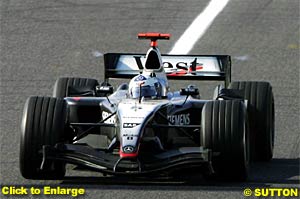 Since Suzuka demands high levels of downforce, the wings were set quite steep and in the humid conditions we were able to view the vortices trailing form the rear wings.
Since Suzuka demands high levels of downforce, the wings were set quite steep and in the humid conditions we were able to view the vortices trailing form the rear wings.
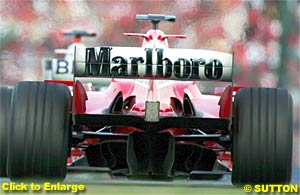 Having run a car revised to some of the 2005 rule changes in Jerez, Ferrari's technical director Ross Brawn commented on a 25 % loss of downforce, which he expects to reduce to around 15% with developments. With such focussed development on next year's car ongoing, no developments were seen on the F2004.
Having run a car revised to some of the 2005 rule changes in Jerez, Ferrari's technical director Ross Brawn commented on a 25 % loss of downforce, which he expects to reduce to around 15% with developments. With such focussed development on next year's car ongoing, no developments were seen on the F2004.
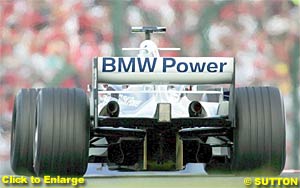 Announcing only a small aero change for this race, Williams appeared with the revised floor seen in China and the narrow nose with a deep curved front wing.
Announcing only a small aero change for this race, Williams appeared with the revised floor seen in China and the narrow nose with a deep curved front wing.
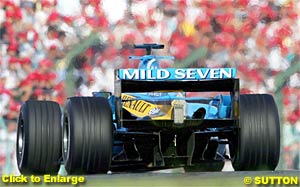 As with most other teams, no new parts were brought to Japan. Mid-field times in Friday's wet sessions were first evidence that the R24 was not working to perfection this weekend.
As with most other teams, no new parts were brought to Japan. Mid-field times in Friday's wet sessions were first evidence that the R24 was not working to perfection this weekend.
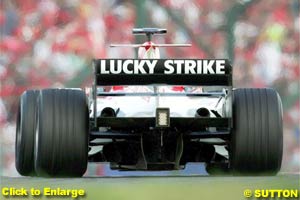 Also they were complaining about aquaplaning more than most, the team had a steady opening practice session. Both qualifying sessions saw the cars running after each other and fairly close on times - but Jenson Button's slow qualifying time was a reflection of his heavier fuel load as he opted for a two stop strategy, over Takuma Sato's three stops.
Also they were complaining about aquaplaning more than most, the team had a steady opening practice session. Both qualifying sessions saw the cars running after each other and fairly close on times - but Jenson Button's slow qualifying time was a reflection of his heavier fuel load as he opted for a two stop strategy, over Takuma Sato's three stops.
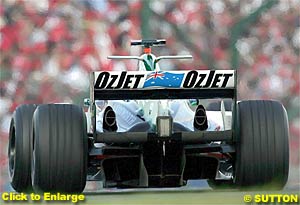 In the race, minor technical maladies slowed the cars. Nick Heidfeld reported gear selection problems and the pitlane speed limiter was cutting while he was on the track. Timo Glock reported handling and gearbox problems, added to his incident while being lapped by Kimi Raikkonen.
In the race, minor technical maladies slowed the cars. Nick Heidfeld reported gear selection problems and the pitlane speed limiter was cutting while he was on the track. Timo Glock reported handling and gearbox problems, added to his incident while being lapped by Kimi Raikkonen.
|
Contact the Author Contact the Editor |
Please Contact Us for permission to republish this or any other material from Atlas F1.
|
Volume 10, Issue 41
Atlas F1 Exclusive
How Pizzonia Recovered his Career
Ann Bradshaw: Point of View
2004 Japanese GP Review
2004 Japanese GP Review
Technical Review: Japan
Dear Ralf
The One-Day Weekend
Stats Center
Qualifying Differentials
SuperStats
Charts Center
Columns
Season Strokes
On the Road
Elsewhere in Racing
The Weekly Grapevine
> Homepage |